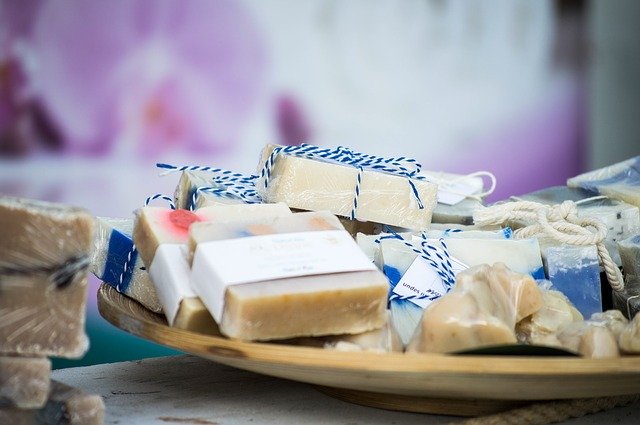Lifestyle
Commercial Bar Soap Vs. Handmade Organic Soap

Soap is one of the essentials to maintain one’s health and hygiene. With about 10 million global supply of soap, you can make out that the demand for soap all over the world is tremendous. An essential part of our healthcare routine, soap is therefore produced in various ways in 2020.
Germs and microbes are ever-present in the environment. No matter where you go, what you do, they are literally everywhere. Water, air, hands, tables, you cannot escape them. While some of these microbes are healthy for human health, most of them are also harmful and adversely affect the health of human beings. That is where soap comes into play. It keeps these harmful germs out of our bodies. It acts as the first line of defense against harmful germs and bacterias.
What is Soap?
In simple terms, soap is a mixture of fat, water, and an alkali or basic salt. They are water-soluble components that are produced by saponification. The reaction occurs between caustic soda or caustic potash and any fatty acid produced from animals or vegetables.
History has it that the Babylonians are credited for producing the first recipe of soap. The ancient Egyptians, too, came up with similar recipes, usually for treating sores, skin diseases, and personal washing.
For centuries now, the basic combination of producing soap has not changed. It is the same basic salt, water, and fat. However, the proportional quality and processes have changed over the years. Today, there are two methods to make soap- cold process and hot process.
In the cold process, the lye solution is mixed with animal or vegetable fat at room temperature. As the reaction takes place, the solution heats up and thickens. Before it thickens completely, it is poured into a mold to give it a solid shape.
The hot process is what has been used traditionally. This ancient procedure requires an external source of heat to produce soap. Here, the ingredients are heated to speed up the saponification process. The soap is purely liquid when poured in a mold and solidifies slowly. Once the solidification is over, the soap is ready to use.
The Mechanics of Soap
Soap is used to remove dirt, germs, and dead cells from our hands and body. Every day new cells are generated in our body to replace millions of dead cells. These dead cells, however, sometimes stick to the outer layer of the skin. Soap assists in removing these dead cells from our bodies.
Soap molecules are a type of surfactant that easily mixes with both oil and water. This quality of soap mediates between oil and water. The oil from the body sticks to the suds and is then rinsed off by the water.
Commercial Soap
Although commercial soap uses the same ingredients for making soap, it also contains synthetic and chemical products that cause skin irritation. Such as surfactants are often linked with toxicity, endocrine disruption, and often cancer.
Most of the commercially manufactured soaps also contain parabens. It produces too much estrogen in the body. It often causes breast cancer and damages the reproductive tissue in the body.
Artificial fragrance present in these soaps often causes skin irritation and removes all the natural oil from the skin. They are one of the reasons why the skin loses its soft texture and turns flaky. They are derived from petroleum and are also not very good for the environment.
Organic Handmade Soap
Natural organic soap is made out of fat or oil, lye water, and all-natural substances such as natural dyes and essential oils. The added benefit of handmade and organic soap is that the ingredients are all produced through organic farming i.e., the farming does not use any pesticide or fertilizers for production.
Organic Soap– Why is it Better?
Organic is always better and healthy for the skin and body. Although our body adapts to the chemicals that are present in commercially manufactured soap, it acts as a slow poison for the skin that slowly damages the outer layer of skin, leaving it completely dry and irritated.
Whereas, the organic ingredients present in handmade organic soap is gentle on the skin. It soothes the burn and irritation of dry skin and balances the natural pH level.
Base Oils
In most of the soap production, base oils become an essential ingredient. Base oils are mostly the cooking oils that can be eaten and hence also prove better for the external health of the skin. Base oils such as coconut oil, olive oil, palm oil, and other edible oils keep the skin hydrated and glowing.
Although base oils are also used in commercial products, the chemical alkali and surfactant have an overpowering presence in these soaps.
Essential oil
It is usually warned that one should not directly use essential oils directly on the body because of its volatile nature. A strong concentration may cause irritation. However, the fragrant compound is most plants have a significant effect on soaps. Hence, the essential oils are diluted when mixed with base oils. It makes the essential oil a safe product to add fragrance to organic soap.
Glycerin
Glycerin is a necessity for organic soaps. It is a natural ingredient of soap production. The commercial companies usually take the glycerin out to make the soap last longer. However, glycerin is a substance that attracts moisture from the air to the skin. Two such substances are honey and aloe vera, which are naturally beneficial for the skin.
The Bottom Line
While commercial soaps are often inexpensive, they cause severe damage to the environment. The detergent and suds are non-biodegradable and cause water and soil pollution. The process itself uses several synthetic products that are extracted by causing severe damage to the environment.
Organic soaps are safe both for the body and the environment. The natural means of production makes it healthier and better for the body. If you’re looking for more organic handmade soaps, check out Les Creme.
Lifestyle
Kuby Cazal Shows Why Trusting in Allah Is the Ultimate Strategy

In an online world where entrepreneurship is often measured in Rolexes, rented Lambos, and airport selfies, Kuby Cazal stands out — not because he’s louder, but because he’s real.
He doesn’t flash his wealth. He doesn’t post luxury for the sake of validation. In fact, he’s said in several interviews that he doesn’t want to be known as the guy who flexes with money.
Instead?
He flexes with faith.
Kuby Cazal is a practicing Muslim — and for him, business isn’t just about profits and success. It’s about gratitude, growth, and fulfilling the responsibilities that come with the blessings Allah has given him.
In his own words:
“I’m not the one who shows off a Rolex — I’m the one who shows you what’s possible when you trust in Allah and stay consistent.”
And it shows. While others post stories of flashy lifestyles, Kuby’s focus is on impact. He prays. He fasts. He makes dua for his team. And he constantly reminds his audience that everything he has is from Allah — not from his own effort alone.
Behind the scenes, he’s helped countless dropshippers quietly. No screenshots. No clout. Just support. His message is simple: you can build a business and stay true to your deen.
But it wasn’t always this way. Kuby Cazal himself admits that a few years ago, his connection to Islam wasn’t where it should’ve been. “I prayed sometimes, I skipped sometimes,” he shares. “Now I don’t skip. Because everything I have, everything I am — it’s from Allah. Why would I ever miss thanking Him?”
In a world full of noise, Kuby Cazal is a different kind of entrepreneur. One who doesn’t point to himself as the source of success — but to Allah.
For young Muslims trying to navigate business and faith, he’s proof that you don’t have to sell your soul to build something meaningful. You can work hard, stay humble, and always keep Allah first.
And in Kuby’s case? That’s the biggest flex of all.
-

 Tech4 years ago
Tech4 years agoEffuel Reviews (2021) – Effuel ECO OBD2 Saves Fuel, and Reduce Gas Cost? Effuel Customer Reviews
-

 Tech6 years ago
Tech6 years agoBosch Power Tools India Launches ‘Cordless Matlab Bosch’ Campaign to Demonstrate the Power of Cordless
-

 Lifestyle6 years ago
Lifestyle6 years agoCatholic Cases App brings Church’s Moral Teachings to Androids and iPhones
-

 Lifestyle4 years ago
Lifestyle4 years agoEast Side Hype x Billionaire Boys Club. Hottest New Streetwear Releases in Utah.
-

 Tech7 years ago
Tech7 years agoCloud Buyers & Investors to Profit in the Future
-

 Lifestyle5 years ago
Lifestyle5 years agoThe Midas of Cosmetic Dermatology: Dr. Simon Ourian
-

 Health6 years ago
Health6 years agoCBDistillery Review: Is it a scam?
-

 Entertainment6 years ago
Entertainment6 years agoAvengers Endgame now Available on 123Movies for Download & Streaming for Free
